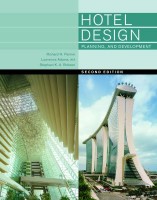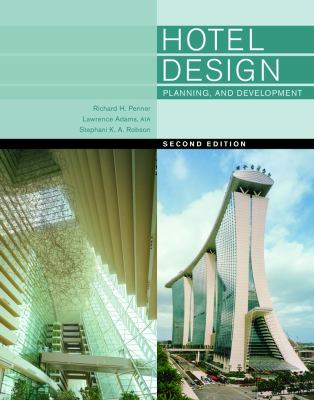 Authors: Richard H. Penner, Lawrence Adams, AIA, and Stephani K.A. Robson
Authors: Richard H. Penner, Lawrence Adams, AIA, and Stephani K.A. Robson
Publisher: W.W. Norton & Company – 444 pages, Hardcover
Book Review by: Sonu Chandiram
This is a very beautifully-designed, elegant, large-format (8 ½” x 11”) book with more than 500 full-color photos and illustrations such as site designs and floor plans that serve to enhance the overall experience of the reader, hotel professional, enthusiast or consumer in enjoying to learn the many aspects of hotels and the hospitality industry.
This second edition released in 2013 takes into account many of the technological innovations in hotel design that developed over the years since the first edition was published in 2001. Many of the hotel-design improvements that developed since then, were added to new hotels; and what were optional amenities in prior years, became necessities and must-have features in hotels that were built later. These are shown and discussed in this essential book for anyone and everyone in the hotel industry.
At that time, most of the hotels were being built in North America, whereas today, the region of rapid hotel development has shifted to Asia, the authors point out. I would add that the Middle East also has many fabulous hotels and hotel construction projects.
Look for example at the incredibly unique designs of the W Mumbai at Namaste Tower on page 105, the Armani Hotel at Burj Khalifa in Dubai on page 106, and the J-Hotel in Shanghai on page 108. It has been noted by many visitors that if you want to really witness economic engines firing on all cylinders, go to Mumbai, Dubai or Shanghai.
Photos of significant hotels constructed since 2001 are shown in this volume. These include a variety of different types of hospitality buildings such as casino hotels, conference centers, convention hotels, design hotels, residential hotels, resort hotels, suburban hotels, urban hotels, and others.
The sizes, shapes, varieties, designs and features – exterior and interior – of the numerous hotels and other commercial resident facilities in Asia, the Middle East and other world regions portrayed in this volume gives the reader an awesome, broad, creative, delightful and welcoming view of the global hospitality business.
This book lays out today’s essential planning and design considerations. The authors write that it gives “increased attention to interior design psychology and the design process” than in the previous version of this book.
Among the important items of information provided in this book are:
- Contributions from key figures in the profession
- Extensive case studies showing best practice examples of hotel design
- Newest developments in design practice and software
- Space-allocation programs and details on planning public areas, guestrooms and suites, and back-of-house facilities
This book is organized into three main sections : a Part 1 – Hotel Types; a Part 2 – Design Guide, with a total 20 chapters; and a list of eight Appendices
To give you an overview and help you plan your reading and study, we name here the titles of the chapters in Part 1 and 2.
Part 1 consists of :
- Overview
- Urban Hotels
- Design Hotels
- Suburban Hotels
- Multi-branded Hotels
- Mixed-Use Developments
- Resort Hotels
- Casino Hotels
- Convention Hotels
- Conference Centers
- Residential Hotels, Condominiums, and Vacation Ownership
- Updating Existing Hotels
Part 2 has chapters on:
- Site and Master Planning
- Programming and Development
- The Guestroom Floor
- Guestroom and Suite Design
- Public Space Design
- Administration and Back-of-House Design
- Technical Coordination and Construction
- Future and Fantasy Development
We urge readers to thoroughly view and enjoy looking at the exterior and interior views of the many hotels around the world featured in this one-of-a-kind volume. Just looking at these images is a learning experience in itself and can give builders, developers, hotel owners and managers, and students a lot of ideas on conceiving and developing new hotels, as well as working out the fine details.
We are sure you will find this book very informative and useful, and we congratulate the authors on this updated edition of what is considered the “bible” for designers, developers, planners and students of hotels.
Richard Penner, professor at the Hotel School at Cornell University since 1970, teaches hotel planning, development, and interior design. Experienced in both architecture and hotel management, he spent year-long sabbaticals with international designer Hirsch Bedner Associates (Santa Monica, California) and the architecture group of Starwood Hotels and Resorts (White Plains, New York).
A graduate of Cornell University, with bachelor’s and master’s degrees in architecture, he is the author of four books—two coauthored with the late Walter Rutes, who was the lead author on the first edition of Hotel Design, Development, and Planning. In 1992 Hospitality Design magazine honored Penner with its Platinum Circle Award for contributions to hospitality design as an author and teacher.
He has presented seminars on development, hotel planning, and interior design throughout the world. He has served a three-year term as Director of Graduate Studies at the Hotel School, has been conference coordinator for design seminars at the European Meeting on Hotel Interior Design in Rimini, Italy, and has chaired five Hospitality Design Roundtables sponsored by the Center for Hospitality Research at Cornell.
Lawrence Adams, AIA, Vice President of ForrestPerkins, has managed and directed the design of large-scale development projects at major architectural and planning firms over the last thirty-five years. A global authority on hotel and resort design, Mr. Adams served as adjunct faculty at New York University for nine years teaching graduate courses on Hotel Design and Development.
He also co-authored Hotel Design, Planning and Development (2001) with Walter Rutes and Richard Penner. Among his most significant projects are the New York Four Seasons Hotel, the RIGHA Royal Hotel, Chambers Hotel, The Westin Beach Resort & Spa, Fort Lauderdale, and the National Headquarters of the Marine Corps Reserve.
Stephani K. A. Robson joined the faculty at the Cornell University School of Hotel Administration in 1993. A specialist in hospitality design psychology, she has contributed numerous research articles to academic journals including the Journal of Environmental Psychology and the Cornell Hospitality Quarterly and frequently writes for trade journals on topics related to hospitality design and development.







